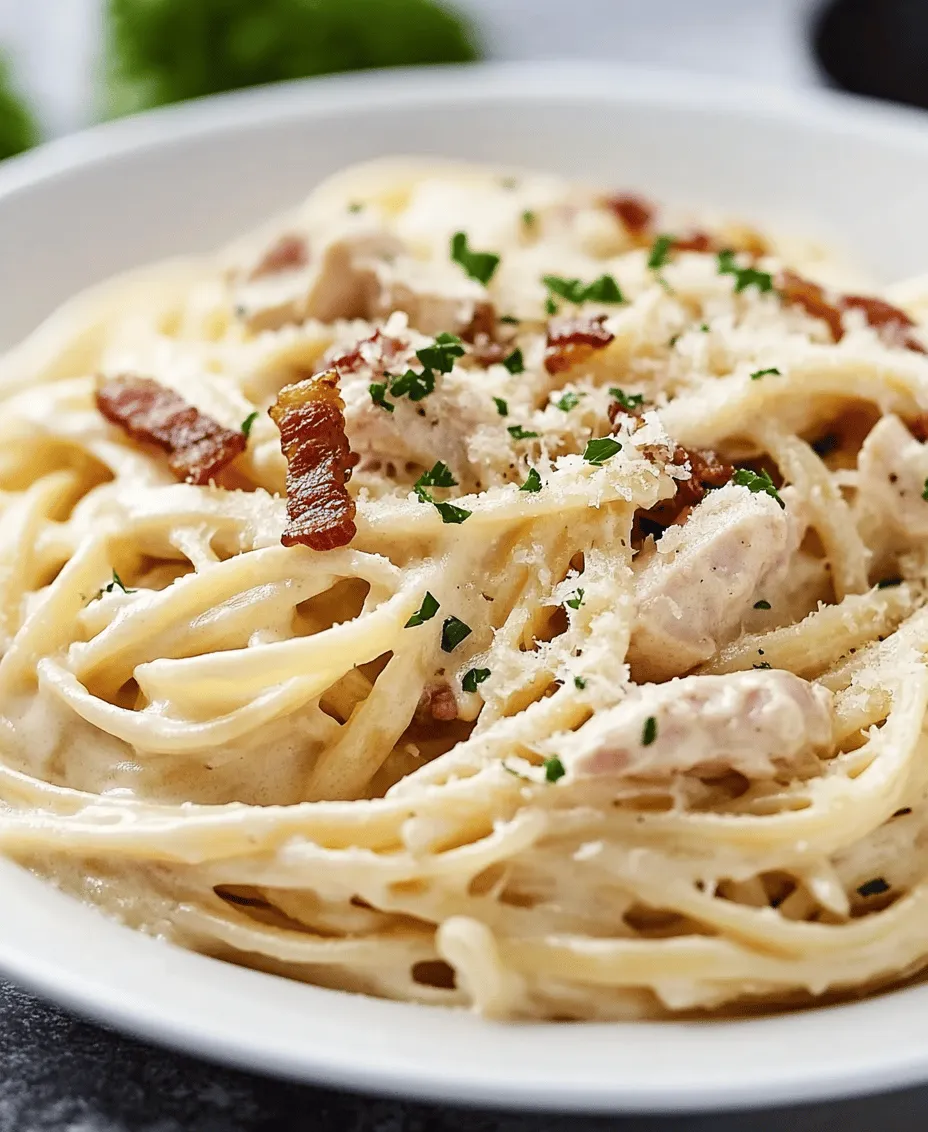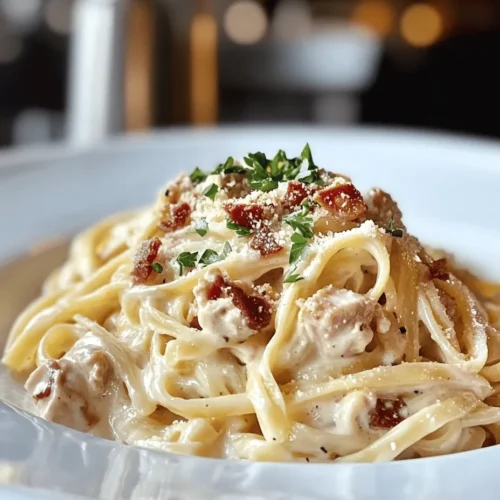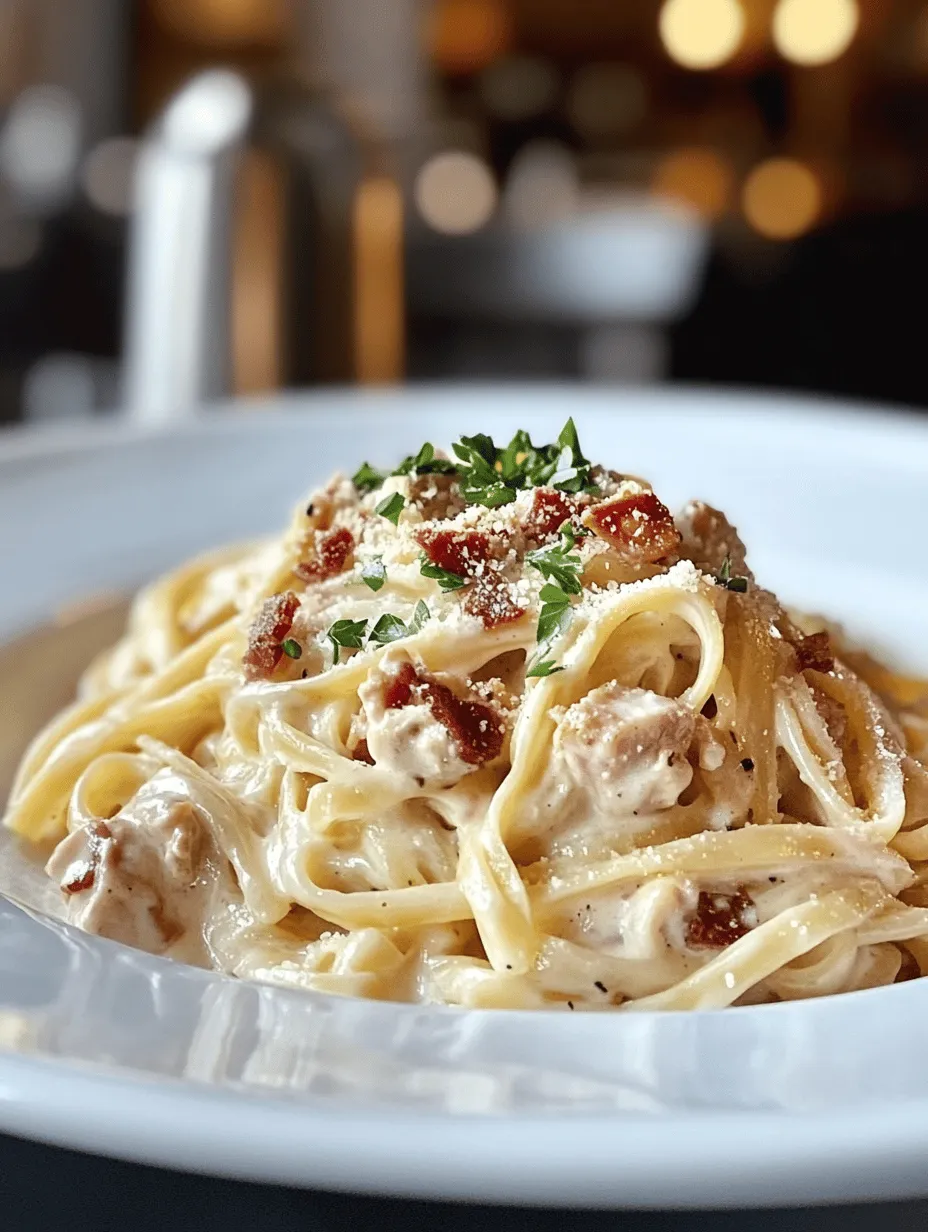Introduction
If you’re on the hunt for a comforting yet sophisticated pasta dish, look no further than Chicken Carbonara. This beloved classic Italian recipe has captivated the hearts—and taste buds—of many around the world. Traditionally, Carbonara is a rich, creamy pasta dish made with eggs, cheese, cured pork, and pepper. However, this recipe gives a delightful twist to the classic by incorporating tender chicken, making it a perfect option for both casual weeknight dinners and special family gatherings.
What sets this Chicken Carbonara apart is its luscious creamy texture, which envelops each strand of pasta in a silky sauce. The combination of ingredients creates a symphony of flavors that are both indulgent and satisfying. In this article, we’ll explore the origins of Chicken Carbonara, break down the key ingredients that contribute to its unique flavor profile, and provide step-by-step cooking instructions to help you achieve the best-ever version of this dish.
Whether you’re a seasoned cook or a beginner in the kitchen, this guide will equip you with everything you need to know to make Chicken Carbonara that will impress your family and friends. From understanding the traditional roots of this dish to diving deep into the ingredients and methods, you’ll find all the information you need to create a delectable meal that is sure to become a favorite in your household.
Understanding Chicken Carbonara
The Origins of Carbonara
Carbonara has its roots deeply embedded in Italian culinary tradition. The dish originated in the Lazio region, specifically in Rome, where it is said to have been created by coal miners (carbonari) who needed a hearty meal to sustain them during their long workdays. The original Carbonara was a simple yet satisfying combination of pasta, eggs, cheese, and guanciale—an Italian cured meat made from pork cheek. Over the years, this classic dish has evolved, and many variations have emerged, adapting to local tastes and available ingredients.
The beauty of Carbonara lies in its simplicity. The traditional recipe doesn’t include cream, relying instead on the emulsification of egg yolks and cheese to create a rich, creamy sauce. However, in this Best-Ever Chicken Carbonara version, we introduce heavy cream to enhance the creaminess, making it even more indulgent.
Ingredients That Define Carbonara
At its core, Chicken Carbonara is built on a few essential ingredients that come together to create a harmonious flavor profile. Here’s a closer look at what makes this dish so special:
– Pasta: The choice of pasta is crucial in Carbonara. While spaghetti is the traditional option, fettuccine can also be used for a heartier bite. The pasta serves as the canvas for the creamy sauce and should be cooked al dente to maintain a perfect texture.
– Chicken: In this recipe, boneless, skinless chicken breasts take center stage as the primary protein. Their mild flavor allows the other ingredients to shine, while their tender texture complements the creaminess of the sauce.
– Thick-Cut Bacon or Guanciale: This ingredient adds a savory, smoky flavor to the dish. While traditional Carbonara uses guanciale, using thick-cut bacon is a widely accepted substitute that enhances the overall flavor and provides a delightful crunch.
– Heavy Cream and Parmesan Cheese: These two ingredients work in unison to create the luxurious, creamy sauce. Heavy cream adds richness, while freshly grated Parmesan cheese contributes a nutty, salty flavor that elevates the dish.
– Egg Yolks: The secret to achieving that silky-smooth texture in Carbonara lies in the egg yolks. When combined with the hot pasta, they create a velvety sauce that clings beautifully to each strand.
– Italian Seasoning and Garlic: These ingredients enhance the overall flavor profile, adding depth and aroma. Italian seasoning brings a blend of herbs that complement the dish, while garlic adds a kick of flavor.
– Fresh Parsley: Finally, a sprinkle of freshly chopped parsley not only adds a pop of color to the dish but also brightens the flavors, making it visually appealing and fresh.
Using high-quality ingredients is essential for achieving the best results. Fresh pasta, artisanal cheeses, and organic chicken can make a significant difference in flavor, ensuring that your Chicken Carbonara is truly exceptional.
Ingredients Breakdown
To make the Best-Ever Chicken Carbonara, you will need the following ingredients:
Key Ingredients
1. Spaghetti or Fettuccine:
– Choice of pasta matters for texture and sauce adherence. Spaghetti is classic, while fettuccine offers a broader surface area for the creamy sauce to cling to.
2. Boneless, Skinless Chicken Breasts:
– This lean protein adds heartiness to the dish. It’s important to cook the chicken until it’s tender and juicy, ensuring that it complements the pasta perfectly.
3. Thick-Cut Bacon:
– The bacon adds a salty, smoky flavor that enhances the richness of the dish. Opt for high-quality bacon to achieve the best flavor.
4. Heavy Cream:
– This ingredient elevates the creaminess of the sauce. Using heavy cream instead of lighter options ensures a thicker, richer texture.
5. Parmesan Cheese:
– Freshly grated Parmesan cheese is crucial for flavor. It melts beautifully into the sauce, creating a deliciously cheesy flavor that’s iconic in Carbonara.
6. Egg Yolks:
– These are essential for achieving the signature silky texture of Carbonara. When mixed with the hot pasta, they create a smooth, creamy sauce without scrambling.
7. Italian Seasoning:
– A blend of herbs like basil, oregano, and thyme adds depth and enhances the overall flavor of the dish.
8. Garlic:
– Fresh garlic provides an aromatic base that complements the richness of the dish. Avoid using garlic powder as it lacks the robust flavor of fresh garlic.
9. Fresh Parsley:
– This herb is used as a garnish and adds a fresh touch to the dish. It not only enhances the presentation but also balances the richness of the Carbonara.
Step-by-Step Cooking Instructions
Now that you have a clear understanding of the key ingredients that will bring your Best-Ever Chicken Carbonara to life, let’s dive into the step-by-step cooking instructions. This section will guide you through the process, ensuring that you create a dish that is both delicious and visually appealing.
1. Prepare the Ingredients:
– Start by gathering all your ingredients. Chop the chicken into bite-sized pieces, dice the bacon, and mince the garlic. Grate the Parmesan cheese and set it aside. Having everything ready will streamline the cooking process.
2. Cook the Pasta:
– In a large pot of salted boiling water, cook your spaghetti or fettuccine according to the package instructions until al dente. Reserve about 1 cup of pasta water, then drain the pasta and set it aside.
3. Cook the Chicken:
– In a large skillet over medium heat, add a splash of olive oil and heat until shimmering. Add the chopped chicken, season with salt and pepper, and sauté until cooked through and golden brown, about 5-7 minutes. Remove the chicken from the skillet and set it aside.
4. Sauté the Bacon:
– In the same skillet, add the diced bacon and cook until crispy, about 4-5 minutes. The bacon will render its fat, which adds flavor to the dish. Once cooked, use a slotted spoon to transfer the bacon to a plate, leaving the fat in the skillet.
5. Add Garlic:
– Lower the heat and add minced garlic to the skillet. Sauté for about 30 seconds, stirring constantly to avoid burning. The garlic should become fragrant and slightly golden.
6. Create the Creamy Sauce:
– Lower the heat and add the heavy cream to the skillet with the garlic. Stir well and allow it to simmer gently for a couple of minutes. Gradually add the grated Parmesan cheese, stirring continuously until it melts and combines with the cream, creating a smooth sauce.
7. Combine Ingredients:
– Return the cooked chicken and crispy bacon to the skillet. Add the drained pasta and toss everything together until the pasta is well coated with the creamy sauce. If the sauce is too thick, gradually add reserved pasta water until you reach the desired consistency.
8. Finish with Egg Yolks:
– Remove the skillet from the heat and immediately stir in the egg yolks, mixing quickly to ensure they create a creamy sauce without scrambling. The residual heat from the pasta and skillet will cook the yolks slightly, giving you that signature Carbonara texture.
9. Season and Serve:
– Taste the pasta and adjust seasoning as needed, adding Italian seasoning, salt, and pepper to your preference. Serve the Chicken Carbonara hot, garnished with freshly chopped parsley and additional Parmesan cheese if desired.
With these detailed instructions, you’re well on your way to preparing a delightful Chicken Carbonara that marries tradition with a modern twist. The creamy sauce, tender chicken, and crispy bacon create a dish that is bound to impress anyone at your dining table. Stay tuned for more cooking tips and serving suggestions in the next part of this article.

Cooking the Pasta
Cooking the pasta is a critical step in making the best-ever Chicken Carbonara, as it forms the foundation of this delicious dish. Start by bringing a large pot of salted water to a rolling boil. The salt not only enhances the flavor of the pasta but also helps it maintain its firmness. Once the water is boiling, add your choice of pasta—traditionally, spaghetti or fettuccine works wonders for Carbonara.
Tips for Achieving Perfectly Cooked Pasta:
1. Timing is Key: Follow the package instructions for cooking time but aim for al dente, which means the pasta should be slightly firm to the bite. Typically, this takes about 8-10 minutes, depending on your pasta type.
2. Reserve Pasta Water: Before draining, always reserve about 1-2 cups of pasta water. This starchy liquid is crucial for adjusting the sauce’s consistency later on, helping it cling to the pasta rather than remaining runny.
3. Don’t Rinse: After draining, do not rinse the pasta. Rinsing washes away the starch that helps the sauce adhere, compromising the dish’s overall texture.
Sautéing the Chicken
While the pasta is cooking, focus on sautéing the chicken. For this recipe, bite-sized pieces of chicken breast work best. Start by seasoning the chicken with salt, pepper, and any additional herbs you prefer, such as dried oregano or Italian seasoning. This enhances the flavor profile, ensuring every bite is delicious.
Techniques for Seasoning and Cooking Chicken to Perfection:
1. Use High Heat: Heat a large skillet over medium-high heat and add a splash of olive oil. Once the oil is shimmering, add the seasoned chicken pieces. This high temperature allows for proper browning, contributing depth to the flavor.
2. Cook in Batches: If the pan seems overcrowded, cook the chicken in batches to avoid steaming. Proper browning leads to caramelization, which adds a rich flavor.
3. Check for Doneness: Chicken is fully cooked when its internal temperature reaches 165°F (75°C). Use a meat thermometer for accuracy or cut into a piece to verify it is no longer pink in the center.
Cooking the Bacon
Next, it’s time to cook the bacon, which adds a delicious smokiness to your Carbonara. Use thick-cut bacon for the best results; it holds up well during cooking and offers a satisfying crunch.
Achieving the Right Level of Crispiness:
1. Cook Slowly: Place the chopped bacon in a cold skillet, then turn the heat to medium. This gradual heating allows the fat to render out slowly, creating crispy, golden pieces without burning.
2. Incorporate Garlic for Aroma: Once the bacon is nearly crispy, add minced garlic to the skillet. This infuses the dish with a fragrant aroma and enhances the overall flavor. Be careful not to burn the garlic; it should be sautéed just until fragrant, about 30 seconds.
Combining Ingredients
Combining all the ingredients is where the magic happens. Timing is essential to ensure that the flavors meld together beautifully. After the chicken and bacon are cooked, remove them from the heat but leave the rendered fat in the pan, as this will be the base for your sauce.
Discussing the Timing and Order of Adding Ingredients:
1. Pasta First: Quickly add the drained pasta to the skillet with the bacon and chicken. Toss to combine, ensuring the pasta is well-coated in the rendered fat.
2. Add Egg Mixture: In a separate bowl, whisk together egg yolks, grated Parmesan cheese, and a generous amount of black pepper. Add this mixture to the pasta while it’s still hot, stirring quickly to create a creamy sauce. The heat from the pasta will cook the eggs gently, forming a velvety sauce without scrambling them.
Making the Sauce
The creamy sauce is what sets Chicken Carbonara apart from other pasta dishes. The key to success lies in tempering the egg yolks correctly to avoid cooking them too quickly.
The Science Behind Tempering Egg Yolks:
1. Gradual Heating: To temper the egg mixture, add a small amount of the reserved pasta water to the yolks while whisking continuously. This raises the temperature of the yolks gradually, preventing them from scrambling when added to the hot pasta.
2. Creating Creaminess: Once tempered, pour the egg mixture into the pasta. The residual heat will create a rich, creamy sauce. If the sauce is too thick, add more reserved pasta water, a little at a time, until the desired consistency is reached.
Tossing the Pasta
Once the sauce is made, it’s time to combine everything thoroughly. Proper tossing ensures that every strand of pasta is coated with the creamy sauce and that the flavors are evenly distributed.
Techniques for Ensuring the Sauce Adheres to the Pasta:
1. Use Tongs: A pair of tongs is the best tool for tossing pasta. They allow you to lift and turn the pasta gently without breaking it.
2. Add Extra Starch: If the sauce seems too thin, a splash of the reserved pasta water can help create a silky texture. This starchy water also helps the sauce cling better to the pasta.
Tips for Perfecting Your Chicken Carbonara
Achieving the perfect Chicken Carbonara can be a challenge, but with a few tips, you can avoid common pitfalls.
Insights on Common Pitfalls to Avoid:
1. Overcooking the Eggs: The biggest mistake is cooking the eggs too quickly, resulting in a scrambled texture instead of a creamy sauce. Always ensure the pasta is hot enough to gently cook the yolks but not so hot that they scramble.
2. Inadequate Seasoning: Taste your dish as you go, adjusting seasoning with salt, pepper, or even more cheese to enhance flavors.
Advice on Adjusting Seasoning and Creaminess:
– If you find the dish lacks richness, consider adding a touch of heavy cream or more cheese. This can elevate the flavor while maintaining a creamy texture.
Suggestions for Variations:
– For added nutrition, consider mixing in sautéed vegetables like peas, spinach, or mushrooms. You could also swap out the chicken for shrimp or even a plant-based protein for a vegetarian option.
Serving Suggestions
Presentation is key to elevating your Chicken Carbonara. Here are some creative ways to plate and serve the dish.
Creative Ways to Plate and Present Chicken Carbonara:
– Serve the pasta in a large, shallow bowl to showcase the creamy sauce and garnish. You can also twirl a portion of pasta with a fork and place it on the plate for an elegant touch.
Pairing Recommendations:
– Chicken Carbonara pairs beautifully with a crisp green salad dressed with a light vinaigrette to balance the richness of the dish. A side of garlic bread can also complement the meal perfectly.
– As for beverages, a glass of chilled white wine, such as Chardonnay or Pinot Grigio, enhances the dish’s flavors and provides a refreshing contrast.
Garnishing Ideas:
– Finish your Chicken Carbonara with a sprinkle of freshly chopped parsley or basil for a pop of color and freshness. A light dusting of additional Parmesan cheese can also enhance the flavor and presentation.
Nutritional Information
Understanding the nutritional content of your Chicken Carbonara can help you enjoy it as part of a balanced diet.
Breakdown of the Nutritional Content per Serving:
– A serving of Chicken Carbonara typically contains around 600-700 calories, depending on the specific ingredients and portion sizes used.
– Key macronutrients include approximately 30g of protein, 40-50g of carbohydrates, and 25g of fat, making it a hearty meal.
Discussion of Calorie Counts and Macro-Nutrients:
– The combination of chicken and bacon provides a good source of protein, while the pasta contributes carbohydrates for energy. The fats from the bacon and cheese add richness but should be consumed in moderation.
Considerations for Dietary Restrictions or Modifications:
– For those with gluten intolerance, gluten-free pasta options are widely available and work just as well in this recipe. You can also substitute the bacon with turkey bacon or a plant-based alternative for a lighter version.
Conclusion
Cooking Chicken Carbonara at home is not just about creating a meal; it’s an experience filled with joy and satisfaction. The rich, creamy sauce paired with perfectly cooked pasta and savory chicken brings the essence of Italian cuisine right to your table.
Embrace the process, enjoy the aromas wafting through your kitchen, and take pride in serving a restaurant-quality dish that you made from scratch. Share your creation with family and friends, and relish the conversations and laughter that accompany a great meal. Chicken Carbonara is more than just a recipe; it’s a celebration of good food and the joy of cooking together.



